Decimals Questions

The decimals questions and answers on this page may assist students in quickly learning the concept. Several questions in almost all competitive and board examinations are based on the idea of “Decimals”. These questions can be used by students to get a rapid overview of the topics and to practice them so that they better comprehend the concept. Double-check your answers by studying the whole explanations for each question. Click here to read more about decimals .
Below are some decimals questions and answers for you to study and practice.

Decimals Questions with Solutions
1. Find the value of 29.94 ÷ 1.45, if 2994 ÷ 14.5 = 172.
Given that, 2994 ÷ 14.5 = 172
29.94/1.45 can be written as 299.4/14.5
Again, 299.4 /14.5 is written in the form as follows:
= [(2994/14.5)×(1/10)
Now, substitute 2994 ÷ 14.5 = 172
= 172 × (1/10)
Hence, the value of 29.94 ÷ 1.45 is 17.2.
2. Simply the value [489.1375 × 0.0483 × 1.956]/[0.0873 × 92.581 × 99.749], and then find the value closest to it.
Now, write the given values rounded to its nearest value.
= 489/(9 × 93 × 10)
= (163/279) × (1/10)
= 0.58/10 = 0.058, which is approximately equal to 0.06.
Hence, the value closest to the expression [489.1375 × 0.0483 × 1.956]/[0.0873 × 92.581 × 99.749] is 0.06.
3. 11.98 × 11.98 + 11.98 × x + 0.02 × 0.02 should be a perfect square for “m” equal to:
Given expression: (11.98 × 11.98 + 11.98 × m + 0.02 × 0.02)
11.98 × 11.98 + 11.98 × m + 0.02 × 0.02 = (11.98) 2 + (0.02) 2 + 11.98 × m.
For the expression to be a perfect square, we should have,
11.98 × m = 2 × 11.98 × 0.02
11.98 × m = 0.4792
Hence, m = 0.4792/11.98
Thus, 11.98 × 11.98 + 11.98 × m + 0.02 × 0.02 should be a perfect square for “m” equal to 0.04.
4. Find the unknown value in the given equation: 3889 + 12.952 – ? = 3854.002
Let the unknown value be a.
Thus, 3889 + 12.952 – a = 3854.002.
Rearranging the above equation, we can write
a = (3889 + 12.952) – 3854.002
a = 3901.952 – 3854.002
Thus, the unknown value is 47.95.
5. Convert the given fractions into decimals and arrange them in ascending order: 1/4, 1/7, 3/4, 6/2, 1/2.
First convert the fractions into decimals.
1/7 = 0.143
Now, arrange the decimal values in the ascending order :
0.143, 0.25, 0.5, 0.75, 3.
6. Find the quotient if 4.036 is divided by 0.04.
Given fraction: 4.036/0.04
Now, multiply the fraction’s numerator and denominator by 100.
4.036/0.04 = 403.6/4 = 100.9.
Thus, 4.036 divided by 0.04 gives 100.9.
7. What is the equivalent of 0.002 × 0.5?
Given expression: 0.002 × 0.5
On simplifying the expression 0.002 × 0.5, we get;
0.002 × 0.5 = 0.001.
8. Write the decimal number for “Fifty Seven and Twenty Three One-Hundredths”.
Fifty-Seven and Twenty Three One-Hundredths is written in the form 57 + (23/100)
Now, simply the above value,
= 57 + 0.23
Hence, Fifty Seven and Twenty Three One-Hundredths in decimal form is 57.23.
9. Jack biked 1.2 miles. Then he ran 0.75 mile. How far did Jack go?
Given: Distance travelled by jack = 1.2 + 0.75 = 1.95.
Hence, the total distance travelled by Jack = 1.95 miles.
10. Convert the fraction 43/100 into decimal form.
To convert the fraction into a decimal, divide the fraction’s numerator by the denominator,
43/100 = 0.43
Hence, the fraction 43/100 is written in decimal form as 0.43.
Practice Questions
- Simply the value: 0.04 × 0.0162.
- Find the value of a, if 0.152 × a = 0.189392
- Find the value of 617 + 6.017 + 0.617 + 6.0017.
Download BYJU’S – The Learning App to learn all Maths-related concepts quickly by exploring more videos.
Leave a Comment Cancel reply
Your Mobile number and Email id will not be published. Required fields are marked *
Request OTP on Voice Call
Post My Comment
Register with BYJU'S & Download Free PDFs
Register with byju's & watch live videos.
Decimals Worksheets
Thanks for visiting the Decimals Worksheets page at Math-Drills.Com where we make a POINT of helping students learn. On this page, you will find Decimals worksheets on a variety of topics including comparing and sorting decimals, adding, subtracting, multiplying and dividing decimals, and converting decimals to other number formats. To start, you will find the general use printables to be helpful in teaching the concepts of decimals and place value. More information on them is included just under the sub-title.
Further down the page, rounding, comparing and ordering decimals worksheets allow students to gain more comfort with decimals before they move on to performing operations with decimals. There are many operations with decimals worksheets throughout the page. It would be a really good idea for students to have a strong knowledge of addition, subtraction, multiplication and division before attempting these questions.
Most Popular Decimals Worksheets this Week


Grids and Charts Useful for Learning Decimals
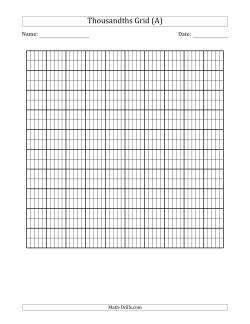
General use decimal printables are used in a variety of contexts and assist students in completing math questions related to decimals.
The thousandths grid is a useful tool in representing decimals. Each small rectangle represents a thousandth. Each square represents a hundredth. Each row or column represents a tenth. The entire grid represents one whole. The hundredths grid can be used to model percents or decimals. The decimal place value chart is a tool used with students who are first learning place value related to decimals or for those students who have difficulty with place value when working with decimals.
- Thousandths and Hundredths Grids Thousandths Grid Hundredths Grids ( 4 on a page) Hundredths Grids ( 9 on a page) Hundredths Grids ( 20 on a page)
- Decimal Place Value Charts Decimal Place Value Chart ( Ones to Hundredths ) Decimal Place Value Chart ( Ones to Thousandths ) Decimal Place Value Chart ( Hundreds to Hundredths ) Decimal Place Value Chart ( Thousands to Thousandths ) Decimal Place Value Chart ( Hundred Thousands to Thousandths ) Decimal Place Value Chart ( Hundred Millions to Millionths )
Decimals in Expanded Form
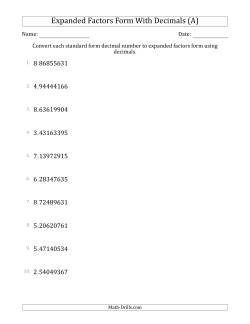
For students who have difficulty with expanded form, try familiarizing them with the decimal place value chart, and allow them to use it when converting standard form numbers to expanded form. There are actually five ways (two more than with integers) to write expanded form for decimals, and which one you use depends on your application or preference. Here is a quick summary of the various ways using the decimal number 1.23. 1. Expanded Form using decimals: 1 + 0.2 + 0.03 2. Expanded Form using fractions: 1 + 2 ⁄ 10 + 3 ⁄ 100 3. Expanded Factors Form using decimals: (1 × 1) + (2 × 0.1) + (3 × 0.01) 4. Expanded Factors Form using fractions: (1 × 1) + (2 × 1 ⁄ 10 ) + (3 × 1 ⁄ 100 ) 5. Expanded Exponential Form: (1 × 10 0 ) + (2 × 10 -1 ) + (3 × 10 -2 )
- Converting Decimals from Standard Form to Expanded Form Using Decimals Converting Decimals from Standard to Expanded Form Using Decimals ( 3 Decimal Places) Converting Decimals from Standard to Expanded Form Using Decimals ( 4 Decimal Places) Converting Decimals from Standard to Expanded Form Using Decimals ( 5 Decimal Places) Converting Decimals from Standard to Expanded Form Using Decimals ( 6 Decimal Places) Converting Decimals from Standard to Expanded Form Using Decimals ( 7 Decimal Places) Converting Decimals from Standard to Expanded Form Using Decimals ( 8 Decimal Places) Converting Decimals from Standard to Expanded Form Using Decimals ( 9 Decimal Places)
- Converting Decimals from Standard Form to Expanded Form Using Fractions Converting Decimals from Standard to Expanded Form Using Fractions ( 3 Decimal Places) Converting Decimals from Standard to Expanded Form Using Fractions ( 4 Decimal Places) Converting Decimals from Standard to Expanded Form Using Fractions ( 5 Decimal Places) Converting Decimals from Standard to Expanded Form Using Fractions ( 6 Decimal Places) Converting Decimals from Standard to Expanded Form Using Fractions ( 7 Decimal Places) Converting Decimals from Standard to Expanded Form Using Fractions ( 8 Decimal Places) Converting Decimals from Standard to Expanded Form Using Fractions ( 9 Decimal Places)
- Converting Decimals from Standard Form to Expanded Factors Form Using Decimals Converting Decimals from Standard to Expanded Factors Form Using Decimals ( 3 Decimal Places) Converting Decimals from Standard to Expanded Factors Form Using Decimals ( 4 Decimal Places) Converting Decimals from Standard to Expanded Factors Form Using Decimals ( 5 Decimal Places) Converting Decimals from Standard to Expanded Factors Form Using Decimals ( 6 Decimal Places) Converting Decimals from Standard to Expanded Factors Form Using Decimals ( 7 Decimal Places) Converting Decimals from Standard to Expanded Factors Form Using Decimals ( 8 Decimal Places) Converting Decimals from Standard to Expanded Factors Form Using Decimals ( 9 Decimal Places)
- Converting Decimals from Standard Form to Expanded Factors Form Using Fractions Converting Decimals from Standard to Expanded Factors Form Using Fractions ( 3 Decimal Places) Converting Decimals from Standard to Expanded Factors Form Using Fractions ( 4 Decimal Places) Converting Decimals from Standard to Expanded Factors Form Using Fractions ( 5 Decimal Places) Converting Decimals from Standard to Expanded Factors Form Using Fractions ( 6 Decimal Places) Converting Decimals from Standard to Expanded Factors Form Using Fractions ( 7 Decimal Places) Converting Decimals from Standard to Expanded Factors Form Using Fractions ( 8 Decimal Places) Converting Decimals from Standard to Expanded Factors Form Using Fractions ( 9 Decimal Places)
- Converting Decimals from Standard Form to Expanded Exponential Form Converting Decimals from Standard to Expanded Exponential Form ( 3 Decimal Places) Converting Decimals from Standard to Expanded Exponential Form ( 4 Decimal Places) Converting Decimals from Standard to Expanded Exponential Form ( 5 Decimal Places) Converting Decimals from Standard to Expanded Exponential Form ( 6 Decimal Places) Converting Decimals from Standard to Expanded Exponential Form ( 7 Decimal Places) Converting Decimals from Standard to Expanded Exponential Form ( 8 Decimal Places) Converting Decimals from Standard to Expanded Exponential Form ( 9 Decimal Places)
- Retro Converting Decimals from Standard Form to Expanded Form Retro Standard to Expanded Form (3 digits before decimal; 2 after) Retro Standard to Expanded Form (4 digits before decimal; 3 after) Retro Standard to Expanded Form (6 digits before decimal; 4 after) Retro Standard to Expanded Form (12 digits before decimal; 3 after)
- Retro European Format Converting Decimals from Standard Form to Expanded Form Standard to Expanded Form (3 digits before decimal; 2 after) Standard to Expanded Form (4 digits before decimal; 3 after) Standard to Expanded Form (6 digits before decimal; 4 after)
Of course, being able to convert numbers already in expanded form to standard form is also important. All five versions of decimal expanded form are included in these worksheets.
- Converting Decimals to Standard Form from Expanded Form Using Decimals Converting Decimals from Expanded Form Using Decimals to Standard Form ( 3 Decimal Places) Converting Decimals from Expanded Form Using Decimals to Standard Form ( 4 Decimal Places) Converting Decimals from Expanded Form Using Decimals to Standard Form ( 5 Decimal Places) Converting Decimals from Expanded Form Using Decimals to Standard Form ( 6 Decimal Places) Converting Decimals from Expanded Form Using Decimals to Standard Form ( 7 Decimal Places) Converting Decimals from Expanded Form Using Decimals to Standard Form ( 8 Decimal Places) Converting Decimals from Expanded Form Using Decimals to Standard Form ( 9 Decimal Places)
- Converting Decimals to Standard Form from Expanded Form Using Fractions Converting Decimals from Expanded Form Using Fractions to Standard Form ( 3 Decimal Places) Converting Decimals from Expanded Form Using Fractions to Standard Form ( 4 Decimal Places) Converting Decimals from Expanded Form Using Fractions to Standard Form ( 5 Decimal Places) Converting Decimals from Expanded Form Using Fractions to Standard Form ( 6 Decimal Places) Converting Decimals from Expanded Form Using Fractions to Standard Form ( 7 Decimal Places) Converting Decimals from Expanded Form Using Fractions to Standard Form ( 8 Decimal Places) Converting Decimals from Expanded Form Using Fractions to Standard Form ( 9 Decimal Places)
- Converting Decimals to Standard Form from Expanded Factors Form Using Decimals Converting Decimals from Expanded Factors Form Using Decimals to Standard Form ( 3 Decimal Places) Converting Decimals from Expanded Factors Form Using Decimals to Standard Form ( 4 Decimal Places) Converting Decimals from Expanded Factors Form Using Decimals to Standard Form ( 5 Decimal Places) Converting Decimals from Expanded Factors Form Using Decimals to Standard Form ( 6 Decimal Places) Converting Decimals from Expanded Factors Form Using Decimals to Standard Form ( 7 Decimal Places) Converting Decimals from Expanded Factors Form Using Decimals to Standard Form ( 8 Decimal Places) Converting Decimals from Expanded Factors Form Using Decimals to Standard Form ( 9 Decimal Places)
- Converting Decimals to Standard Form from Expanded Factors Form Using Fractions Converting Decimals from Expanded Factors Form Using Fractions to Standard Form ( 3 Decimal Places) Converting Decimals from Expanded Factors Form Using Fractions to Standard Form ( 4 Decimal Places) Converting Decimals from Expanded Factors Form Using Fractions to Standard Form ( 5 Decimal Places) Converting Decimals from Expanded Factors Form Using Fractions to Standard Form ( 6 Decimal Places) Converting Decimals from Expanded Factors Form Using Fractions to Standard Form ( 7 Decimal Places) Converting Decimals from Expanded Factors Form Using Fractions to Standard Form ( 8 Decimal Places) Converting Decimals from Expanded Factors Form Using Fractions to Standard Form ( 9 Decimal Places)
- Converting Decimals to Standard Form from Expanded Exponential Form Converting Decimals from Expanded Exponential Form to Standard Form ( 3 Decimal Places) Converting Decimals from Expanded Exponential Form to Standard Form ( 4 Decimal Places) Converting Decimals from Expanded Exponential Form to Standard Form ( 5 Decimal Places) Converting Decimals from Expanded Exponential Form to Standard Form ( 6 Decimal Places) Converting Decimals from Expanded Exponential Form to Standard Form ( 7 Decimal Places) Converting Decimals from Expanded Exponential Form to Standard Form ( 8 Decimal Places) Converting Decimals from Expanded Exponential Form to Standard Form ( 9 Decimal Places)
- Retro Converting Decimals to Standard Form from Expanded Form Retro Expanded to Standard Form (3 digits before decimal; 2 after) Retro Expanded to Standard Form (4 digits before decimal; 3 after) Retro Expanded to Standard Form (6 digits before decimal; 4 after) Retro Expanded to Standard Form (12 digits before decimal; 3 after)
- Retro European Format Converting Decimals to Standard Form from Expanded Form Retro European Format Expanded to Standard Form (3 digits before decimal; 2 after) Retro European Format Expanded to Standard Form (4 digits before decimal; 3 after) Retro European Format Expanded to Standard Form (6 digits before decimal; 4 after)
Rounding Decimals Worksheets
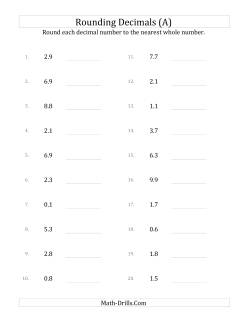
Rounding decimals is similar to rounding whole numbers; you have to know your place value! When learning about rounding, it is also useful to learn about truncating since it may help students to round properly. A simple strategy for rounding involves truncating, using the digits after the truncation to determine whether the new terminating digit remains the same or gets incremented, then taking action by incrementing if necessary and throwing away the rest. Here is a simple example: Round 4.567 to the nearest tenth. First, truncate the number after the tenths place 4.5|67. Next, look at the truncated part (67). Is it more than half way to 99 (i.e. 50 or more)? It is, so the decision will be to increment. Lastly, increment the tenths value by 1 to get 4.6. Of course, the situation gets a little more complicated if the terminating digit is a 9. In that case, some regrouping might be necessary. For example: Round 6.959 to the nearest tenth. Truncate: 6.9|59. Decide to increment since 59 is more than half way to 99. Incrementing results in the necessity to regroup the tenths into an extra one whole, so the result is 7.0. Watch that students do not write 6.10. You will want to correct them right away in that case. One last note: if there are three truncated digits then the question becomes is the number more than half way to 999. Likewise, for one digit; is the number more than half way to 9. And so on...
We should also mention that in some scientific and mathematical "circles," rounding is slightly different "on a 5". For example, most people would round up on a 5 such as: 6.5 --> 7; 3.555 --> 3.56; 0.60500 --> 0.61; etc. A different way to round on a 5, however, is to round to the nearest even number, so 5.5 would be rounded up to 6, but 8.5 would be rounded down to 8. The main reason for this is not to skew the results of a large number of rounding events. If you always round up on a 5, on average, you will have slightly higher results than you should. Because most pre-college students round up on a 5, that is what we have done in the worksheets that follow.
- Rounding Decimals to Whole Numbers Round Tenths to a Whole Number Round Hundredths to a Whole Number Round Thousandths to a Whole Number Round Ten Thousandths to a Whole Number Round Various Decimals to a Whole Number
- Rounding Decimals to Tenths Round Hundredths to Tenths Round Thousandths to Tenths Round Ten Thousandths to Tenths Round Various Decimals to Tenths
- Rounding Decimals to Hundredths Round Thousandths to Hundredths Round Ten Thousandths to Hundredths Round Various Decimals to Hundredths
- Rounding Decimals to Thousandths Round Ten Thousandths to Thousandths
- Rounding Decimals to Various Decimal Places Round Hundredths to Various Decimal Places Round Thousandths to Various Decimal Places Round Ten Thousandths to Various Decimal Places Round Various Decimals to Various Decimal Places
- European Format Rounding Decimals to Whole Numbers European Format Round Tenths to a Whole Number European Format Round Hundredths to a Whole Number European Format Round Thousandths to a Whole Number European Format Round Ten Thousandths to Whole Number
- European Format Rounding Decimals to Tenths European Format Round Hundredths to Tenths European Format Round Thousandths to Tenths European Format Round Ten Thousandths to Tenths
- European Format Rounding Decimals to Hundredths European Format Round Thousandths to Hundredths European Format Round Ten Thousandths to Hundredths
- European Format Rounding Decimals to Thousandths European Format Round Ten Thousandths to Thousandths
Comparing and Ordering/Sorting Decimals Worksheets.
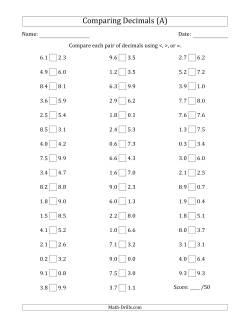
The comparing decimals worksheets have students compare pairs of numbers and the ordering decimals worksheets have students compare a list of numbers by sorting them.
Students who have mastered comparing whole numbers should find comparing decimals to be fairly easy. The easiest strategy is to compare the numbers before the decimal (the whole number part) first and only compare the decimal parts if the whole number parts are equal. These sorts of questions allow teachers/parents to get a good idea of whether students have grasped the concept of decimals or not. For example, if a student thinks that 4.93 is greater than 8.7, then they might need a little more instruction in place value. Close numbers means that some care was taken to make the numbers look similar. For example, they could be close in value, e.g. 3.3. and 3.4 or one of the digits might be changed as in 5.86 and 6.86.
- Comparing Decimals up to Tenths Comparing Decimals up to Tenths ( Both Numbers Random ) Comparing Decimals up to Tenths ( One Digit Differs ) Comparing Decimals up to Tenths ( Both Numbers Close in Value ) Comparing Decimals up to Tenths ( Various Tricks )
- Comparing Decimals up to Hundredths Comparing Decimals up to Hundredths ( Both Numbers Random ) Comparing Decimals up to Hundredths ( One Digit Differs ) Comparing Decimals up to Hundredths ( Two Digits Swapped ) Comparing Decimals up to Hundredths ( Both Numbers Close in Value ) Comparing Decimals up to Hundredths ( One Number has an Extra Digit ) Comparing Decimals up to Hundredths ( Various Tricks )
- Comparing Decimals up to Thousandths Comparing Decimals up to Thousandths Comparing Decimals up to Thousandths ( One Digit Differs ) Comparing Decimals up to Thousandths ( Two Digits Swapped ) Comparing Decimals up to Thousandths ( Both Numbers Close in Value ) Comparing Decimals up to Thousandths ( One Number has an Extra Digit ) Comparing Decimals up to Thousandths ( Various Tricks )
- Comparing Decimals up to Ten Thousandths Comparing Decimals up to Ten Thousandths Comparing Decimals up to Ten Thousandths ( One Digit Differs ) Comparing Decimals up to Ten Thousandths ( Two Digits Swapped ) Comparing Decimals up to Ten Thousandths ( Both Numbers Close in Value ) Comparing Decimals up to Ten Thousandths ( One Number has an Extra Digit ) Comparing Decimals up to Ten Thousandths ( Various Tricks )
- Comparing Decimals up to Hundred Thousandths Comparing Decimals up to Hundred Thousandths Comparing Decimals up to Hundred Thousandths ( One Digit Differs ) Comparing Decimals up to Hundred Thousandths ( Two Digits Swapped ) Comparing Decimals up to Hundred Thousandths ( Both Numbers Close in Value ) Comparing Decimals up to Hundred Thousandths ( One Number has an Extra Digit ) Comparing Decimals up to Hundred Thousandths ( Various Tricks )
- European Format Comparing Decimals European Format Comparing Decimals up to Tenths European Format Comparing Decimals up to Tenths (tight) European Format Comparing Decimals up to Hundredths European Format Comparing Decimals up to Hundredths (tight) European Format Comparing Decimals up to Thousandths European Format Comparing Decimals up to Thousandths (tight)
Ordering decimals is very much like comparing decimals except there are more than two numbers. Generally, students determine the least (or greatest) decimal to start, cross it off the list then repeat the process to find the next lowest/greatest until they get to the last number. Checking the list at the end is always a good idea.
- Ordering/Sorting Decimals Ordering/Sorting Decimal Hundredths Ordering/Sorting Decimal Thousandths
- European Format Ordering/Sorting Decimals European Format Ordering/Sorting Decimal Tenths (8 per set) European Format Ordering/Sorting Decimal Hundredths (8 per set) European Format Ordering/Sorting Decimal Thousandths (8 per set) European Format Ordering/Sorting Decimal Ten Thousandths (8 per set) European Format Ordering/Sorting Decimals with Various Decimal Places(8 per set)
Converting Decimals to Fractions and Other Number Formats
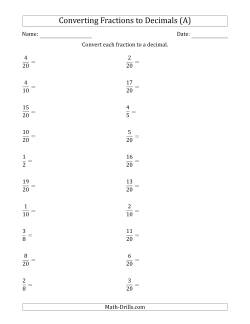
There are many good reasons for converting decimals to other number formats. Dealing with a fraction in arithmetic is often easier than the equivalent decimal. Consider 0.333... which is equivalent to 1/3. Multiplying 300 by 0.333... is difficult, but multiplying 300 by 1/3 is super easy! Students should be familiar with some of the more common fraction/decimal conversions, so they can switch back and forth as needed.
- Converting Between Decimals and Fractions Converting Fractions to Terminating Decimals Converting Fractions to Terminating and Repeating Decimals Converting Terminating Decimals to Fractions Converting Terminating and Repeating Decimals to Fractions Converting Fractions to Hundredths
- Converting Between Decimals, Fraction, Percents and Ratios Converting Fractions to Decimals, Percents and Part-to-Part Ratios Converting Fractions to Decimals, Percents and Part-to-Whole Ratios Converting Decimals to Fractions, Percents and Part-to-Part Ratios Converting Decimals to Fractions, Percents and Part-to-Whole Ratios Converting Percents to Fractions, Decimals and Part-to-Part Ratios Converting Percents to Fractions, Decimals and Part-to-Whole Ratios Converting Part-to-Part Ratios to Fractions, Decimals and Percents Converting Part-to-Whole Ratios to Fractions, Decimals and Percents Converting Various Fractions, Decimals, Percents and Part-to-Part Ratios Converting Various Fractions, Decimals, Percents and Part-to-Whole Ratios Converting Various Fractions, Decimals, Percents and Part-to-Part Ratios with 7ths and 11ths Converting Various Fractions, Decimals, Percents and Part-to-Whole Ratios with 7ths and 11ths
Adding and Subtracting Decimals
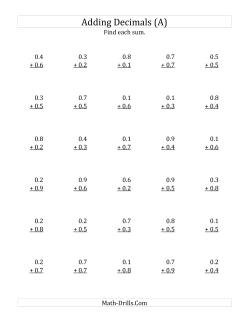
Try the following mental addition strategy for decimals. Begin by ignoring the decimals in the addition question. Add the numbers as if they were whole numbers. For example, 3.25 + 4.98 could be viewed as 325 + 498 = 823. Use an estimate to decide where to place the decimal. In the example, 3.25 + 4.98 is approximately 3 + 5 = 8, so the decimal in the sum must go between the 8 and the 2 (i.e. 8.23)
- Adding Tenths Adding Decimal Tenths with 0 Before the Decimal (range 0.1 to 0.9) Adding Decimal Tenths with 1 Digit Before the Decimal (range 1.1 to 9.9) Adding Decimal Tenths with 2 Digits Before the Decimal (range 10.1 to 99.9)
- Adding Hundredths Adding Decimal Hundredths with 0 Before the Decimal (range 0.01 to 0.99) Adding Decimal Hundredths with 1 Digit Before the Decimal (range 1.01 to 9.99) Adding Decimal Hundredths with 2 Digits Before the Decimal (range 10.01 to 99.99)
- Adding Thousandths Adding Decimal Thousandths with 0 Before the Decimal (range 0.001 to 0.999) Adding Decimal Thousandths with 1 Digit Before the Decimal (range 1.001 to 9.999) Adding Decimal Thousandths with 2 Digits Before the Decimal (range 10.001 to 99.999)
- Adding Ten Thousandths Adding Decimal Ten Thousandths with 0 Before the Decimal (range 0.0001 to 0.9999) Adding Decimal Ten Thousandths with 1 Digit Before the Decimal (range 1.0001 to 9.9999) Adding Decimal Ten Thousandths with 2 Digits Before the Decimal (range 10.0001 to 99.9999)
- Adding Various Decimal Places Adding Various Decimal Places with 0 Before the Decimal Adding Various Decimal Places with 1 Digit Before the Decimal Adding Various Decimal Places with 2 Digits Before the Decimal Adding Various Decimal Places with Various Numbers of Digits Before the Decimal
- European Format Adding Decimals European Format Adding decimal tenths with 0 before the decimal (range 0,1 to 0,9) European Format Adding decimal tenths with 1 digit before the decimal (range 1,1 to 9,9) European Format Adding decimal hundredths with 0 before the decimal (range 0,01 to 0,99) European Format Adding decimal hundredths with 1 digit before the decimal (range 1,01 to 9,99) European Format Adding decimal thousandths with 0 before the decimal (range 0,001 to 0,999) European Format Adding decimal thousandths with 1 digit before the decimal (range 1,001 to 9,999) European Format Adding decimal ten thousandths with 0 before the decimal (range 0,0001 to 0,9999) European Format Adding decimal ten thousandths with 1 digit before the decimal (range 1,0001 to 9,9999) European Format Adding mixed decimals with Various Decimal Places European Format Adding mixed decimals with Various Decimal Places (1 to 9 before decimal)
Base ten blocks can be used for decimal subtraction. Just redefine the blocks, so the big block is a one, the flat is a tenth, the rod is a hundredth and the little cube is a thousandth. Model and subtract decimals using base ten blocks, so students can "see" how decimals really work.
- Subtracting Tenths Subtracting Decimal Tenths with No Integer Part Subtracting Decimal Tenths with an Integer Part in the Minuend Subtracting Decimal Tenths with an Integer Part in the Minuend and Subtrahend
- Subtracting Hundredths Subtracting Decimal Hundredths with No Integer Part Subtracting Decimal Hundredths with an Integer Part in the Minuend and Subtrahend Subtracting Decimal Hundredths with a Larger Integer Part in the Minuend
- Subtracting Thousandths Subtracting Decimal Thousandths with No Integer Part Subtracting Decimal Thousandths with an Integer Part in the Minuend and Subtrahend
- Subtracting Ten Thousandths Subtracting Decimal Ten Thousandths with No Integer Part Subtracting Decimal Ten Thousandths with an Integer Part in the Minuend and Subtrahend
- Subtracting Various Decimal Places Subtracting Various Decimals to Hundredths Subtracting Various Decimals to Thousandths Subtracting Various Decimals to Ten Thousandths
- European Format Subtracting Decimals European Format Decimal subtraction (range 0,1 to 0,9) European Format Decimal subtraction (range 1,1 to 9,9) European Format Decimal subtraction (range 0,01 to 0,99) European Format Decimal subtraction (range 1,01 to 9,99) European Format Decimal subtraction (range 0,001 to 0,999) European Format Decimal subtraction (range 1,001 to 9,999) European Format Decimal subtraction (range 0,0001 to 0,9999) European Format Decimal subtraction (range 1,0001 to 9,9999) European Format Decimal subtraction with Various Decimal Places European Format Decimal subtraction with Various Decimal Places (1 to 9 before decimal)
Adding and subtracting decimals is fairly straightforward when all the decimals are lined up. With the questions arranged horizontally, students are challenged to understand place value as it relates to decimals. A wonderful strategy for placing the decimal is to use estimation. For example if the question is 49.2 + 20.1, the answer without the decimal is 693. Estimate by rounding 49.2 to 50 and 20.1 to 20. 50 + 20 = 70. The decimal in 693 must be placed between the 9 and the 3 as in 69.3 to make the number close to the estimate of 70.
The above strategy will go a long way in students understanding operations with decimals, but it is also important that they have a strong foundation in place value and a proficiency with efficient strategies to be completely successful with these questions. As with any math skill, it is not wise to present this to students until they have the necessary prerequisite skills and knowledge.
- Horizontally Arranged Adding Decimals Adding Decimals to Tenths Horizontally Adding Decimals to Hundredths Horizontally Adding Decimals to Thousandths Horizontally Adding Decimals to Ten Thousandths Horizontally Adding Decimals Horizontally With Up to Two Places Before and After the Decimal Adding Decimals Horizontally With Up to Three Places Before and After the Decimal Adding Decimals Horizontally With Up to Four Places Before and After the Decimal
- Horizontally Arranged Subtracting Decimals Subtracting Decimals to Tenths Horizontally Subtracting Decimals to Hundredths Horizontally Subtracting Decimals to Thousandths Horizontally Subtracting Decimals to Ten Thousandths Horizontally Subtracting Decimals Horizontally With Up to Two Places Before and After the Decimal Subtracting Decimals Horizontally With Up to Three Places Before and After the Decimal Subtracting Decimals Horizontally With Up to Four Places Before and After the Decimal
- Horizontally Arranged Mixed Adding and Subtracting Decimals Adding and Subtracting Decimals to Tenths Horizontally Adding and Subtracting Decimals to Hundredths Horizontally Adding and Subtracting Decimals to Thousandths Horizontally Adding and Subtracting Decimals to Ten Thousandths Horizontally Adding and Subtracting Decimals Horizontally With Up to Two Places Before and After the Decimal Adding and Subtracting Decimals Horizontally With Up to Three Places Before and After the Decimal Adding and Subtracting Decimals Horizontally With Up to Four Places Before and After the Decimal
Multiplying and Dividing Decimals
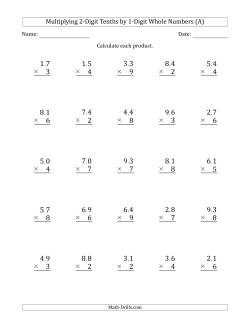
Multiplying decimals by whole numbers is very much like multiplying whole numbers except there is a decimal to deal with. Although students might initially have trouble with it, through the power of rounding and estimating, they can generally get it quite quickly. Many teachers will tell students to ignore the decimal and multiply the numbers just like they would whole numbers. This is a good strategy to use. Figuring out where the decimal goes at the end can be accomplished by counting how many decimal places were in the original question and giving the answer that many decimal places. To better understand this method, students can round the two factors and multiply in their head to get an estimate then place the decimal based on their estimate. For example, multiplying 9.84 × 91, students could first round the numbers to 10 and 91 (keep 91 since multiplying by 10 is easy) then get an estimate of 910. Actually multiplying (ignoring the decimal) gets you 89544. To get that number close to 910, the decimal needs to go between the 5 and the 4, thus 895.44. Note that there are two decimal places in the factors and two decimal places in the answer, but estimating made it more understandable rather than just a method.
- Multiplying Decimals by 1-Digit Whole Numbers Multiply 2-digit tenths by 1-digit whole numbers Multiply 2-digit hundredths by 1-digit whole numbers Multiply 2-digit thousandths by 1-digit whole numbers Multiply 3-digit tenths by 1-digit whole numbers Multiply 3-digit hundredths by 1-digit whole numbers Multiply 3-digit thousandths by 1-digit whole numbers Multiply various decimals by 1-digit whole numbers
- Multiplying Decimals by 2-Digit Whole Numbers Multiplying 2-digit tenths by 2-digit whole numbers Multiplying 2-digit hundredths by 2-digit whole numbers Multiplying 3-digit tenths by 2-digit whole numbers Multiplying 3-digit hundredths by 2-digit whole numbers Multiplying 3-digit thousandths by 2-digit whole numbers Multiplying various decimals by 2-digit whole numbers
- Multiplying Decimals by Tenths Multiplying 2-digit whole by 2-digit tenths Multiplying 2-digit tenths by 2-digit tenths Multiplying 2-digit hundredths by 2-digit tenths Multiplying 3-digit whole by 2-digit tenths Multiplying 3-digit tenths by 2-digit tenths Multiplying 3-digit hundredths by 2-digit tenths Multiplying 3-digit thousandths by 2-digit tenths Multiplying various decimals by 2-digit tenths
- Multiplying Decimals by Hundredths Multiplying 2-digit whole by 2-digit hundredths Multiplying 2-digit tenths by 2-digit hundredths Multiplying 2-digit hundredths by 2-digit hundredths Multiplying 3-digit whole by 2-digit hundredths Multiplying 3-digit tenths by 2-digit hundredths Multiplying 3-digit hundredths by 2-digit hundredths Multiplying 3-digit thousandths by 2-digit hundredths Multiplying various decimals by 2-digit hundredths
- Multiplying Decimals by Various Decimal Places Multiplying 2-digit by 2-digit numbers with various decimal places Multiplying 3-digit by 2-digit numbers with various decimal places
- Decimal Long Multiplication in Various Ranges Decimal Multiplication (range 0.1 to 0.9) Decimal Multiplication (range 1.1 to 9.9) Decimal Multiplication (range 10.1 to 99.9) Decimal Multiplication (range 0.01 to 0.99) Decimal Multiplication (range 1.01 to 9.99) Decimal Multiplication (range 10.01 to 99.99) Random # Digits Random # Places
- European Format Multiplying Decimals by 2-Digit Whole Numbers European Format 2-digit whole × 2-digit hundredths European Format 2-digit tenths × 2-digit whole European Format 2-digit hundredths × 2-digit whole European Format 3-digit tenths × 2-digit whole European Format 3-digit hundredths × 2-digit whole European Format 3-digit thousandths × 2-digit whole
- European Format Multiplying Decimals by 2-Digit Tenths European Format 2-digit whole × 2-digit tenths European Format 2-digit tenths × 2-digit tenths European Format 2-digit hundredths × 2-digit tenths European Format 3-digit whole × 2-digit tenths European Format 3-digit tenths × 2-digit tenths European Format 3-digit hundredths × 2-digit tenths European Format 3-digit thousandths × 2-digit tenths
- European Format Multiplying Decimals by 2-Digit Hundredths European Format 2-digit tenths × 2-digit hundredths European Format 2-digit hundredths × 2-digit hundredths European Format 3-digit whole × 2-digit hundredths European Format 3-digit tenths × 2-digit hundredths European Format 3-digit hundredths × 2-digit hundredths European Format 3-digit thousandths × 2-digit hundredths
- European Format Multiplying Decimals by Various Decimal Places European Format 2-digit × 2-digit with various decimal places European Format 3-digit × 2-digit with various decimal places
- Dividing Decimals by Whole Numbers Divide Tenths by a Whole Number Divide Hundredths by a Whole Number Divide Thousandths by a Whole Number Divide Ten Thousandths by a Whole Number Divide Various Decimals by a Whole Number
In case you aren't familiar with dividing with a decimal divisor, the general method for completing questions is by getting rid of the decimal in the divisor. This is done by multiplying the divisor and the dividend by the same amount, usually a power of ten such as 10, 100 or 1000. For example, if the division question is 5.32/5.6, you would multiply the divisor and dividend by 10 to get the equivalent division problem, 53.2/56. Completing this division will result in the exact same quotient as the original (try it on your calculator if you don't believe us). The main reason for completing decimal division in this way is to get the decimal in the correct location when using the U.S. long division algorithm.
A much simpler strategy, in our opinion, is to initially ignore the decimals all together and use estimation to place the decimal in the quotient. In the same example as above, you would complete 532/56 = 95. If you "flexibly" round the original, you will get about 5/5 which is about 1, so the decimal in 95 must be placed to make 95 close to 1. In this case, you would place it just before the 9 to get 0.95. Combining this strategy with the one above can also help a great deal with more difficult questions. For example, 4.584184 ÷ 0.461 can first be converted the to equivalent: 4584.184 ÷ 461 (you can estimate the quotient to be around 10). Complete the division question without decimals: 4584184 ÷ 461 = 9944 then place the decimal, so that 9944 is about 10. This results in 9.944.
Dividing decimal numbers doesn't have to be too difficult, especially with the worksheets below where the decimals work out nicely. To make these worksheets, we randomly generated a divisor and a quotient first, then multiplied them together to get the dividend. Of course, you will see the quotients only on the answer page, but generating questions in this way makes every decimal division problem work out nicely.
- Decimal Long Division with Quotients That Work Out Nicely Dividing Decimals by Various Decimals with Various Sizes of Quotients Dividing Decimals by 1-Digit Tenths (e.g. 0.72 ÷ 0.8 = 0.9) Dividing Decimals by 1-Digit Tenths with Larger Quotients (e.g. 3.2 ÷ 0.5 = 6.4) Dividing Decimals by 2-Digit Tenths (e.g. 10.75 ÷ 2.5 = 4.3) Dividing Decimals by 2-Digit Tenths with Larger Quotients (e.g. 387.75 ÷ 4.7 = 82.5) Dividing Decimals by 3-Digit Tenths (e.g. 1349.46 ÷ 23.8 = 56.7) Dividing Decimals by 2-Digit Hundredths (e.g. 0.4368 ÷ 0.56 = 0.78) Dividing Decimals by 2-Digit Hundredths with Larger Quotients (e.g. 1.7277 ÷ 0.39 = 4.43) Dividing Decimals by 3-Digit Hundredths (e.g. 31.4863 ÷ 4.61 = 6.83) Dividing Decimals by 4-Digit Hundredths (e.g. 7628.1285 ÷ 99.91 = 76.35) Dividing Decimals by 3-Digit Thousandths (e.g. 0.076504 ÷ 0.292 = 0.262) Dividing Decimals by 3-Digit Thousandths with Larger Quotients (e.g. 2.875669 ÷ 0.551 = 5.219)
These worksheets would probably be used for estimating and calculator work.
- Horizontally Arranged Decimal Division Random # Digits Random # Places
- European Format Dividing Decimals with Quotients That Work Out Nicely European Format Divide Tenths by a Whole Number European Format Divide Hundredths by a Whole Number European Format Divide Thousandths by a Whole Number European Format Divide Ten Thousandths by a Whole Number European Format Divide Various Decimals by a Whole Number
In the next set of questions, the quotient does not always work out well and may have repeating decimals. The answer key shows a rounded quotient in these cases.
- European Format Dividing Decimals by Whole Numbers European Format Divide Tenths by a Whole Number European Format Divide Hundredths by a Whole Number European Format Divide Thousandths by a Whole Number European Format Divide Ten Thousandths by a Whole Number European Format Divide Various Decimals by a Whole Number
- European Format Dividing Decimals by Decimals European Format Decimal Tenth (0,1 to 9,9) Divided by Decimal Tenth (1,1 to 9,9) European Format Decimal Hundredth (0,01 to 9,99) Divided by Decimal Tenth (1,1 to 9,9) European Format Decimal Thousandth (0,001 to 9,999) Divided by Decimal Tenth (1,1 to 9,9) European Format Decimal Ten Thousandth (0,0001 to 9,9999) Divided by Decimal Tenth (1,1 to 9,9) European Format Various Decimal Places (0,1 to 9,9999) Divided by Decimal Tenth (1,1 to 9,9) European Format Various Decimal Places (0,1 to 9,9999) Divided by Various Decimal Places (1,1 to 9,9999)
Copyright © 2005-2024 Math-Drills.com You may use the math worksheets on this website according to our Terms of Use to help students learn math.

IMAGES